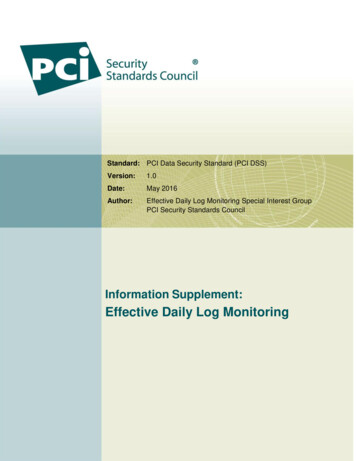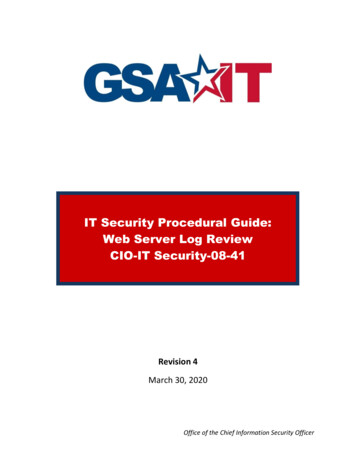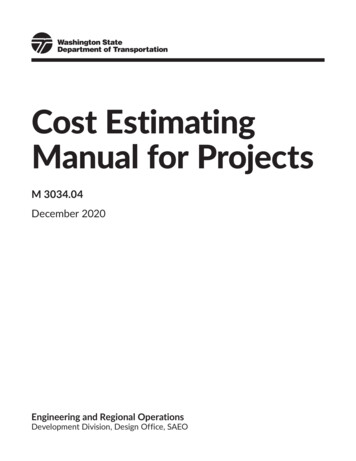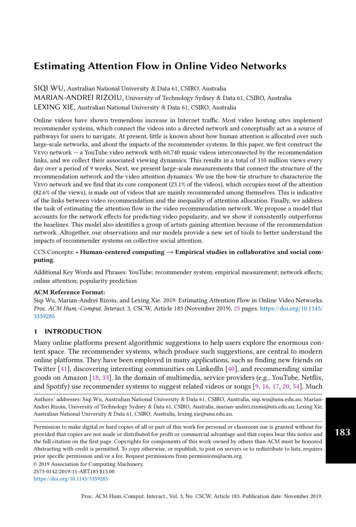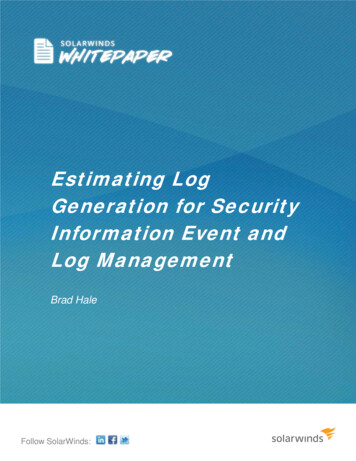
Transcription
Estimating LogGeneration for SecurityInformation Event andLog ManagementBrad HaleFollow SolarWinds:
Estimating Log Generation for SecurityInformation Event ManagementSolarWinds Is Trusted ByAs more solutions enter the marketplace claiming to collect, analyze and correlate log data, it isbecoming increasingly necessary to have the ability to estimate log generation for one’senvironment. This is required for two primary reasons: to estimate the amount of storage requiredfor log data; and to estimate the cost of various solutions given their licensing model. This paperwill discuss an approach to estimating the amount of log data generated in a hypothetical networkenvironment.DisclaimerThere is no one size fits all for estimating log generation. Factors that impact the amount of datagenerated include, but are not limited to: network complexity and design including number and typeof devices on your network (switches, routers, firewalls, servers, etc ) and load on each device;device logging policies, especially the severity level for which logs are generated and which logsyou actually want to collect and monitor; and size in bytes of the log generated.First, The BasicsEvery device in your IT infrastructure generates log data that can be used to analyze andtroubleshoot performance or security related issues. What one does with the data depends onwhat one is trying to accomplish with the data and is usually categorized as either LogManagement or Security Information Event Management.According to Wikipedia (therefore, we know it must be accurate – queue the laugh track), LogManagement (LM) comprises the approach to dealing with large volumes of computer-generatedlog messages. LM covers log collection, centralized aggregation, long-term retention, log analysis,log search, and reporting. LM is primarily driven by reasons of security, system and networkoperations (such as system or network administration) and regulatory compliance.Security Information Event ManagementSIEM, also known as security information management (SIM) or security event management(SEM), goes beyond LM by not only performing the data aggregation, but also includingcorrelation, alerting and presentation in a graphical dashboard for the purpose of compliance andretention. Essentially, SIEM adds the intelligence to LM so that IT professionals can more pro-SolarWindsLog & Event Manageractively monitor and manage the security and operations of their IT infrastructure.Under either approach, one needs the ability to collect the data from the various sources and thatdata will vary greatly in the amount and frequency of the data generated.Follow SolarWinds:Fully-Functional for 30 Days
Events per SecondThe most common approach to determining how much log data will be generated is to use Events per Second (EPS). EPS isexactly what it is called, the number of log or system events that are generated by a device every second.𝐸𝑃𝑆 # 𝑜𝑓 𝑆𝑦𝑠𝑡𝑒𝑚 𝐸𝑣𝑒𝑛𝑡𝑠𝑇𝑖𝑚𝑒 𝑃𝑒𝑟𝑖𝑜𝑑 𝑖𝑛 𝑆𝑒𝑐𝑜𝑛𝑑𝑠But, why is EPS important and how is it used? Using EPS will help you scope or determine:An appropriate LM or SIEM – since many LMs or SIEMs are rated or licensed based on EPS or amount of logged data, it iscritical that you have an accurate estimate of your EPS or else you risk oversizing (paying too much) or under sizing (losingdata) your solution.Your online and offline storage requirements – if you have compliance requirements then you will have some type of retentionpolicy. Your retention policy along with the amount of log data generated will determine your storage requirement.Your daily storage management – Storage costs money and you don’t want to spend more than you have to, however, you donot want to run out of storage either. Understanding your EPS will better allow you to manage and plan your log data storageneeds.Normal vs. PeakThere are two EPS metrics that need to be factored into your planning and analysis: Normal Events per Second (𝑁𝐸𝑥 ), andPeak Events per Second (𝑃𝐸𝑥 ).𝑁𝐸𝑥 , just as its name implies, represents the normal number of events per second while 𝑃𝐸𝑥 , represents the peak number ofevents that are caused by abnormal activities such as a security attack. While 𝑃𝐸𝑥 is a theoretical, albeit impractical,measurement, it does need to be factored in as it could impact the performance of your SIEM/LM solution as well as yourstorage requirements.Why should you be concerned about 𝑃𝐸𝑥 ? Quite simply, a single security incident such as a worm, virus or DOS may fire offthousands of events per second from the firewall, IPS, router, or switch at a single gateway. Multiply this by your multiplesubnets and it can quickly spiral out of control.Log VolumeNow that we understand our EPS, we can estimate the amount of log data that is being generated per second and per daybased on the following formulas:(𝐸𝑃𝑆 𝑥 𝐵𝑦𝑡𝑒𝑠 𝑃𝑒𝑟 𝐸𝑣𝑒𝑛𝑡)𝐺𝐵𝑦𝑡𝑒𝑠 𝑜𝑓 𝐷𝑎𝑡𝑎 ���𝑒𝑠 𝑜𝑓 𝐷𝑎𝑡𝑎𝐺𝑏𝑦𝑡𝑒𝑠 𝑜𝑓 𝐷𝑎𝑡𝑎 64,800𝐷𝑎𝑦𝑆𝑒𝑐𝑜𝑛𝑑Some SIEM and LM solutions in the market license by the amount of log data collected, or indexed, on a daily basis. Thiscalculation will allow you to estimate the size of the license required under that model.Follow SolarWinds:2
In addition, by applying the above calculation to your data retention policies, you can estimate the amount of storage requiredfor your log data.𝐺𝑏𝑦𝑡𝑒𝑠 𝑆𝑡𝑜𝑟𝑎𝑔𝑒 (𝐸𝑃𝑆 𝑥 𝐵𝑦𝑡𝑒𝑠 𝑃𝑒𝑟 𝐸𝑣𝑒𝑛𝑡)𝑥 64,800 𝑥 𝑅𝑒𝑡𝑒𝑛𝑡𝑖𝑜𝑛 𝑃𝑒𝑟𝑖𝑜𝑑 (𝑖𝑛 𝑑𝑎𝑦𝑠)1,000,000,000Our Hypothetical InfrastructureNow let’s apply what I have discussed so far to a hypothetical mid-sized organization with 1000 employees located across 5sites and containing one data center (see network diagram).Follow SolarWinds:3
DISCLAIMER AGAIN: The estimates in the following table are simply best estimates for EPS and should be used only forillustrative purposes. The most accurate measurement of EPS is to use a simple syslog server, such as Kiwi Syslog Server,and measure actual EPS over a period of time.Quantity100055522TypeDescriptionAvg. RouterWindowsDomain ServerWindowsApplicationServerDesktops & Laptops(.005 EPS/Employee)One @ each location NetFlow EnabledLinux Serverat Data 10500525021501505502055020Totals36322,09013,100Avg Log Size Bytes/Day3.13190.86113.18One @ each locationOne @ each locationat Data CenterOne @ each location, 2@ Data CenterHigh availability cluster@ Data CenterExchange Server3Web Servers (IIS,Apache, Tomcat)2Windows DNSServerat Data Center -failover4Database ServerMSSQL, Oracle, Sybase,etc ):2FirewallTrustedFirewall7IPS/IDS1VPNDMZ1 @ each location, 1 inDMZ, 1 in Trustedat Data Center facingthe internet1000AntiSpam/Proxy.005 EPS/employee1000Antivirus Server.005 EPS/employeeFollow SolarWinds:Avg. Peak EPS562Peak EPS4
As you can see from this example, it is quite easy to be generating multiple GBytes of log data per day with just normal activity.If one were to scale their SIEM, LM or storage based on the peak load or average peak load, then it can get quite expensive.SummaryAs stated at the beginning of this paper, there is no simple “rule-of-thumb” approach to estimating the amount of log data thatcan be generated by an organization. There are simply too many factors that have an impact. When scoping a SIEM or LMsolution, the most accurate method to determine log data generation is to take a sample over a given time period using asimple syslog server tool that can tell you exactly how much data his being generated.If you are concerned about the uncertainty of volume based licensing models for a SIEM or LM solution, then you can,alternatively, evaluate products that license based on the number of nodes that are monitored. Node based licensing will offera more predictable cost without having to go through the exercise of estimating log volume. SolarWinds Log & Event Manageris an example of a low-cost, easy-to-use, software based Security Information Event Management/Log Management solutionthat collects, correlates, and analyzes log data in real-time. Learn more about SolarWinds Log & Event Manager.Follow SolarWinds:5
for log data; and to estimate the cost of various solutions given their licensing model. This paper will discuss an approach to estimating the amount of log data generated in a hypothetical network environment. Disclaimer . There is no one size fits all for estimating log generation. Factors that impact the amount of data generated include, but are not limited to: network complexity and design .


